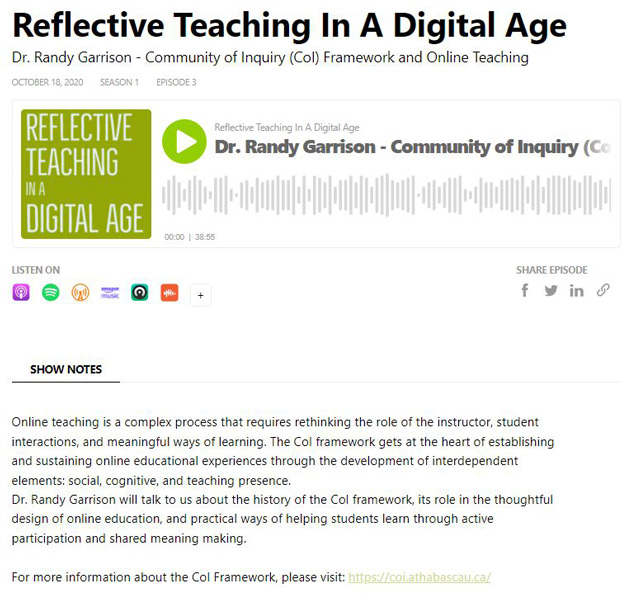A reflection on Community of Inquiry Model
This was a week full of learning and experiencing new things! I’ve been teaching for many years and I have attended many online seminars and courses in the past, but this week I realized how much online learning (and teaching) has changed over the years and how much is still evolving! Many years ago, I attended a one-year distance training program about the teaching of Greek as a Second/Foreign Language offered by the Centre for the Greek Language, a non-profit research state institute, supervised by the Greek Ministry of Education. Although, it was pioneering for its era and for Greece, during that course I had to study material, do projects, pass assessments etc. but I never had the sense of community or learned anything from my other classmates as there wasn’t any other kind of interaction except the one with the instructor; I really felt on my own and isolated during the whole program. So, when last summer I started here, at BSU, I expected something similar, but pretty soon I realized that this was a completely different experience. This week’s readings helped me understand why. The majority of the components of the Community of Inquiry Framework (Garrison, 2007) were present in all the BSU courses I’ve taken so far, and most of the professors have done an excellent job integrating them into their courses. The CoI framework gives more attention to the role of the students in the learning process and helps them to create meaningful learning experiences through the development of three interdependent elements – social, cognitive, and teaching presence.
So, in these courses, cognitive presence was developed through the deployment of active learning strategies, such as reflection, problem-based learning, critical thinking and debate. From all of these strategies I believe that reflection that I encountered in all of the BSU courses so far is the most powerful! Reflection can help learners “grow as self-directed, independent learners who are in control of their own learning” and “develop plans for continuous improvement” (Stavredes, 2011, p. 113). Reflection requires critical thinking skills and it is a very internal process as you try to see what the readings mean for you and how they can help you grow.
The other aspect of the CoI framework, the social presence, is formed when you interact with other people & develop interpersonal relationships, when you collaborate, communicate and work together with your classmates. Discussions, team or group projects and peer reviews are some of the elements through which this aspect unfolds. As a result of this week’s discussion, for example, I was able to learn about important online tools that I can utilize in my classroom. Through peer review and discussion in the other course I am attending this semester I had the opportunity to improve an interactive model I am constructing for my students. Discussions and peer reviews help you “see” different points of view that maybe you haven’t considered, give you ideas of improvement, correct mistakes that might have passed unnoticed and in general help you take one step further from where you would have reached on your own.
But all these elements need to be carefully structured and planned and this is where teaching presence is essential and important. The teacher/instructor/facilitator is responsible for the overall design and structure of every course, it is he/she that guides, coordinates, directs and motivates the learners, initiates discussions, encourages participation, knowledge construction and critical thinking, monitors progress, gives timely feedback. The teacher of an online course should wear many different hats and his/her role is very important. For example, interactions and discussions, as I mentioned earlier, play a key role in an online course but not without a structure and direction, “without explicit guidance, students will engage in ‘serial monologues’” (Garrison, 2007, C, para. 3). In order for someone to understand the importance of teaching presence, I believe it is enough to imagine an online course without activities-learning goal alignment, with no structure, no assessment rubrics or feedback, with overwhelming material, or unguided discussions.
In their paper Anderson et al (2011) liken online learning to teaching in a one-room schoolhouse. This analogy emphasizes that, far from being a passive and inert present, the online instructor has an important and complex role to play. He/she is responsible for “the design, facilitation, and direction of cognitive and social processes with the aim of attaining personally meaningful and educationally desirable learning results.” (Anderson et al., 2011, p. 5).
So, the instructor of an online course should design the course with specific guidelines as we learned in our previous unit, “provide intellectual and scholarly leadership (Anderson et al, 2001, p8) that means that he/she should be there for the students to offer resources, correct misconceptions and confirm understanding. Furthermore, he/she should facilitate and regularly monitor and comment on students’ work and postings in order to keep everyone motivated and engaged. So, although not so obvious at the beginning, it is the teacher who puts everything together and who is behind every big or small decision, every aspect of what is offered online.
This week’s readings were very revealing for me and besides the readings I was lucky enough to find and enjoy (as I was doing my every day walk) a beautiful podcast from “Reflecting Teaching in A Digital Age” in which Dr. Randy Garrison himself discusses the origins of the CoI framework, its significance in online education design, and practical approaches to help students learn via active involvement and shared meaning building. I am sharing it with you here and I hope you enjoy it as well.






